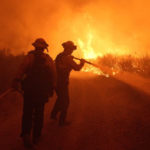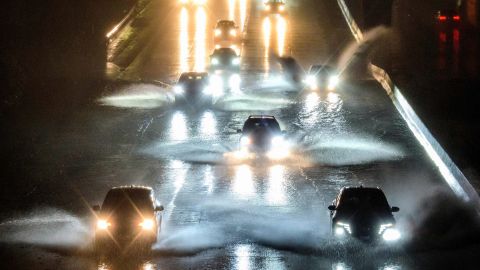CNN
—
A deadly storm that lashed coastal California with hurricane-force winds and torrential rain is far from over.
Now, big cities including Los Angeles, San Francisco and Sacramento are getting walloped by the powerful cyclone.
About 35 million people – or 90% of the California population – are under a flood watch Thursday. Much of California, which has been marred by drought, wildfires and recent flooding, can barely absorb any more moisture.
And yet another storm this weekend will bring even more rain and wind, threatening to topple trees and power lines from increasingly saturated ground.
Some areas near Malibu got deluged with more than 2 inches of rain in six hours Thursday morning – which “could lead to mudslides, especially over recent burn areas,” CNN meteorologist Dave Hennen said.
Rainfall rates exceeding 1 inch per hour are possible – which could exacerbate flooding and cause mudslides in areas still recovering from last weekend’s deadly flooding.
At least two deaths have already been linked to the latest storm.

In Sonoma County, a young child – about age 1 or 2 – was killed Wednesday when a redwood tree fell on a home, Occidental Volunteer Fire Department Chief Ron Lunardi said.
And a 19-year-old woman died Wednesday after crashing her car into a utility pole on a flooded road in Northern California, the Fairfield Police Department said.
The road was partially flooded “due to heavy rain pummeling the area,” Fairfield police said. The driver hit “a patch of standing water and hydroplaned, losing control of the vehicle, before colliding into a utility pole.” Unsafe speed was likely the primary cause of the crash, and the flooded roadway was a contributing factor, police said.
In nearby San Francisco, “floods are inevitable,” Mayor London Breed warned Wednesday. “It’s coming down hard and it’s not letting up any time soon,” she said. “We want people to stay indoors, we want them to stay home.”
The city had already seen some localized flooding, a couple of mudslides and sinkholes as of Wednesday evening, said Mary Ellen Carol, executive director of San Francisco’s Department of Emergency Management.
The low-pressure storm system moved in from the Pacific, bringing damaging winds, excessive rainfall and extremely heavy snow over much of California and into southern Oregon through Thursday.
In central California, wind gusts had already reached hurricane force by Wednesday evening as the storm’s heaviest rain and strongest winds slammed into the Bay Area.
Winds gusts topped 130 mph at Hopper Canyon and Alpine Meadows, and 119 mph in Kirkwood Meadows. Elsewhere in Grapevine Peak, Pulga and Nicasio, wind gusts exceeded 100 mph. And in Oregon’s Squaw Peak, wind gusts reached 106 mph.
About 180,000 homes and businesses in California were without power early Thursday – most in the northern part of the state, according to PowerOutage.US.
“We anticipate this may be the most challenging and impactful series of storms to touch down in California in the last five years,” California Director of Emergency Services Nancy Ward said. “If the storm materializes as we anticipate. We could see widespread flooding, mudslides, and power outages in many communities.”
In the Sierra Nevada, the heavy snowfall is forecast to add at least 3 feet over the peaks and create hazardous conditions, with potential tree damage and whiteout conditions.
After a yearslong drought, parts of California can only absorb a limited amount of water. In many areas, the ground has already reached its saturation point from storms in late December and over New Year’s weekend.
As a result, the influx of water is expected to unleash major flooding in some places.
“We’re moving from extreme drought to extreme floods,” California Water Resources Director Karla Nemeth said.
Nemeth said burn scar areas and other sensitive terrain could become the sites of dangerous mudslides.
“The public is urged to be on the lookout for potential flooding and mudslides in areas recently burned by wildfires,” state officials warned. “A debris flow can take homes off their foundations and carry items such as vegetation, large boulders, and cars.”
Some residents were also told to flee ahead of the storm’s arrival. Evacuations were ordered in some areas of Santa Cruz and Santa Barbara counties, including for those near lands ravaged by fires in previous years.
Among the areas ordered to evacuate is Montecito, the site of a mudslide in 2018 that killed 23 people as mud and boulders the size of houses plowed down the Santa Barbara hillsides, splintering more than 100 homes and rupturing a gas main, according to the state’s Office of Emergency Services.
“I’m urging folks to comply with the evacuation,” said Das Williams, first district supervisor in Santa Barbara County. “If you live in that red zone, the one thing that we should’ve learned these past five years is that it’s better to play it safe and to evacuate and comply with the order.”

California’s largest gas and electric utility company, Pacific Gas and Electric, said the storm damaged its equipment and caused widespread outages Wednesday evening.
“We’re seeing a significant number of trees falling into our lines, as well as other impacts on our power system,” PG&E spokesperson Teresa Alvarado tweeted. “We’ve mobilized for a major repair and restoration effort.”
But with the storm expected to saturate roads and knock down trees, it may be difficult for crews to reach areas without power, said Aaron Johnson, vice president of PG&E’s Bay Area region.
“We’re really looking at an unprecedented weather event,” Johnson said.
Author Profile
- "Far Left" Bias Rating
- The Cable News Network is a multinational cable news channel headquartered in Atlanta, Georgia, U.S. Founded in 1980 by American media proprietor Ted Turner and Reese Schonfeld as a 24-hour cable news channel.
Latest entries
 HeadlinesAugust 17, 2024A mom with a license plate that reads 'PB4WEGO' wins a battle with the state to keep it
HeadlinesAugust 17, 2024A mom with a license plate that reads 'PB4WEGO' wins a battle with the state to keep it HeadlinesAugust 3, 20243 alleged gang members and an associate charged in the fatal shooting of an off-duty LAPD officer
HeadlinesAugust 3, 20243 alleged gang members and an associate charged in the fatal shooting of an off-duty LAPD officer HeadlinesJuly 16, 2024June 18 2024: US heat wave news
HeadlinesJuly 16, 2024June 18 2024: US heat wave news HeadlinesJuly 11, 2024Jury begins deliberations in Hunter Biden's federal gun trial
HeadlinesJuly 11, 2024Jury begins deliberations in Hunter Biden's federal gun trial

